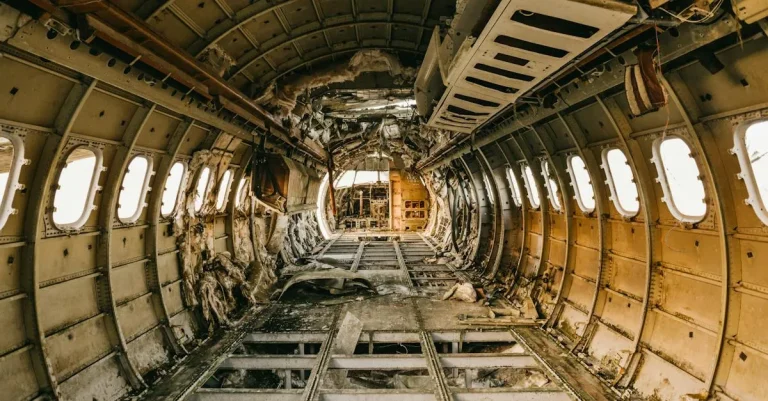When Was The Last Commercial Plane Crash In The United States?
If you have ever wondered when the last major commercial airline crash was in the United States that took lives, you’re not alone. With over 2.7 million people flying on US commercial airlines every day, air travel safety is a major concern for many.
If you’re short on time, here’s a quick answer: The last commercial plane crash in the US that resulted in fatalities was Colgan Air Flight 3407 in February 2009 near Buffalo, New York, which tragically took 50 lives.
In this comprehensive article, we will explore the details of that crash and other recent commercial aviation accidents in America. We’ll look at NTSB investigation findings, changes made to improve safety, as well as statistics that showcase the incredible safety improvements in modern airline travel.
Details of the Colgan Air Flight 3407 Crash in 2009
The Flight and Crash
Colgan Air Flight 3407 was a scheduled passenger flight from Newark, New Jersey, to Buffalo, New York, that tragically crashed on February 12, 2009. The flight was operated by Colgan Air, a regional airline under contract with Continental Connection.
The aircraft involved was a Bombardier Dash 8 Q400, a twin-engine turboprop plane.
The crash occurred during the final approach to Buffalo Niagara International Airport. The National Transportation Safety Board (NTSB) investigation revealed that the aircraft had entered an aerodynamic stall due to the crew’s inappropriate response to the stall warning system.
The plane then descended rapidly and crashed into a residential area in Clarence Center, New York, resulting in the deaths of all 49 people on board and one person on the ground.
Investigation and Contributing Factors
The investigation into the Colgan Air Flight 3407 crash identified several contributing factors. One major factor was the inadequate training and fatigue of the flight crew. It was discovered that both the captain and the first officer had failed multiple proficiency tests and had not received sufficient training to handle stall recovery procedures.
Additionally, both pilots had a history of fatigue and inadequate sleep, which likely impaired their decision-making abilities.
Another contributing factor was the ineffective oversight of the Federal Aviation Administration (FAA) in ensuring the safety of regional airlines. The NTSB found that the FAA had not adequately monitored Colgan Air’s training programs, crew scheduling practices, and pilot performance.
This lack of oversight allowed deficiencies to go unnoticed and contributed to the crash.
Changes and Improvements After the Crash
The Colgan Air Flight 3407 crash led to significant changes and improvements in aviation safety. The crash prompted the implementation of the Airline Safety and Federal Aviation Administration Extension Act of 2010, which aimed to enhance pilot training and qualifications, improve crew rest requirements, and strengthen oversight of regional airlines.
Furthermore, the FAA introduced new regulations requiring airlines to implement more rigorous pilot training programs, including enhanced stall recovery training. Airlines were also required to establish fatigue risk management systems to address the issue of pilot fatigue.
These measures have since contributed to a significant reduction in aviation accidents and improved passenger safety.
The tragic event of Colgan Air Flight 3407 served as a turning point in aviation safety and highlighted the need for continuous improvement and vigilance in the industry. By learning from past mistakes and implementing necessary changes, the aviation community has made significant strides in enhancing safety and preventing similar incidents from occurring in the future.
Review of Other Recent Crashes
While commercial plane crashes are rare in the United States, there have been a few notable incidents in recent years. Let’s take a closer look at two of them:
JetBlue Flight 292 in 2005
One of the most memorable incidents in recent years was the emergency landing of JetBlue Flight 292 in 2005. The plane, an Airbus A320, experienced a malfunction with its landing gear, causing it to land with the front wheels turned 90 degrees to the side.
The skilled pilots managed to safely land the aircraft at Los Angeles International Airport, and all 139 passengers and crew members on board escaped without any major injuries. This incident highlighted the importance of pilot training and quick thinking in emergency situations.
Southwest Airlines Flight 1248 in 2005
Another significant crash occurred in 2005 when Southwest Airlines Flight 1248 overran the runway while landing at Chicago Midway International Airport. The Boeing 737-700 slid off the end of the runway and crashed through a fence before coming to a stop on a road.
Unfortunately, a six-year-old boy in a car on the road was killed, and several other people were injured. This incident prompted investigators to review runway safety and the importance of maintaining appropriate distances for stopping aircraft.
These incidents serve as a reminder that even with extensive safety measures in place, accidents can still happen. It is crucial for airlines and aviation authorities to continually review and improve safety protocols to minimize the risk of future incidents.
Just How Safe is Flying on US Commercial Airlines?
When it comes to flying on US commercial airlines, safety is always a top concern for passengers. However, the reality is that flying is one of the safest modes of transportation. The aviation industry has made significant advancements in safety measures over the years, resulting in a remarkable safety record.
Statistics on Accidents and Fatalities
Statistical data shows that commercial plane crashes in the United States have become increasingly rare. In fact, the last major commercial plane crash in the US occurred on February 12, 2009, when Colgan Air Flight 3407 crashed near Buffalo, New York, resulting in 50 fatalities.
Since then, there have been no fatal commercial plane crashes in the US.
The United States has one of the safest aviation systems in the world, with strict regulations and rigorous safety standards in place. According to the National Transportation Safety Board (NTSB), the accident rate for US scheduled passenger airlines has been consistently low for the past decade.
In 2019, US carriers operated nearly 10 million flights without a single accident.
It is important to note that while accidents may still occur, the likelihood of being involved in one is extremely low. The Federal Aviation Administration (FAA) reports that the odds of being in a fatal plane crash in the US are about 1 in 29 million flights.
This statistic demonstrates the high level of safety and reliability of US commercial airlines.
How Airlines Continue to Improve Safety
Airlines and aviation authorities are continually working to improve safety standards and reduce the risk of accidents. They invest heavily in technology, training, and maintenance to ensure the highest level of safety for passengers and crew.
One area of focus is pilot training. Airlines have rigorous training programs that include simulator exercises, emergency scenarios, and thorough evaluations. Additionally, pilots are required to undergo regular recurrent training to stay up-to-date with the latest safety procedures and regulations.
Another key aspect of airline safety is aircraft maintenance. Airlines adhere to strict maintenance schedules and conduct regular inspections to identify and address any potential issues. Moreover, technological advancements have enabled airlines to monitor the condition of their aircraft in real-time, allowing for proactive maintenance and minimizing the risk of mechanical failures.
Collaboration between airlines, manufacturers, and regulatory bodies is also crucial for improving safety. The FAA and other international aviation organizations work closely with airlines and aircraft manufacturers to establish and enforce safety standards.
This collaboration ensures that safety practices are continuously evaluated and updated to keep up with emerging technologies and potential risks.
Conclusion
As we have explored, the last fatal commercial airline crash in America was over 13 years ago in 2009. While any loss of life is tragic, the level of safety achieved in airline travel today is remarkable compared to early days of aviation.
With extensive training requirements, aircraft redundancies, rigorous maintenance, and an overall culture of safety first, passengers can feel reassured when flying on US commercial carriers. While nothing is ever 100% risk-free, your odds of being involved in a deadly crash are infinitesimally small.








